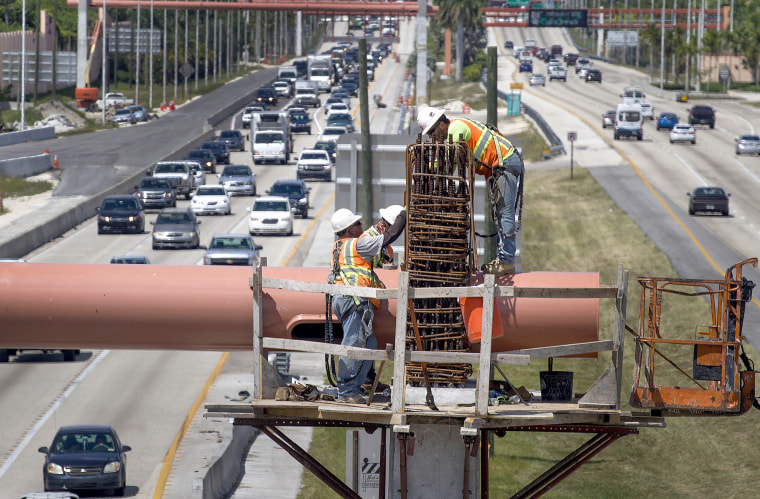As the saber rattling continues between Washington and Beijing, some sectors of the American economy have been hit harder than others. But with the threat of additional tariffs on $325 billion of Chinese imports, a wider swath of industries in the U.S. will begin to feel the pain — as will consumers.
Tariffs in the ongoing trade war with China have already scored victims. Among them are the customers of Marker Construction, a home-building company in Fort Lauderdale, Florida.
"We've seen a price increase of at least 15 percent with anything that involves steel," company president Peggy Marker told NBC News. The increased price of nails, screws, metal framing, and reinforcement rods now get passed on to her commercial clients, driving up project costs by hundreds of thousands of dollars.
"They have to estimate with the worst-case scenario and then wait and see what happens," Marker said. "Now that there's a deal on the table with Mexico and Canada, that may help settle down the market as well," she added, referring to the recent agreement for the U.S. and its neighbors to drop tariffs on imported aluminum and steel.
As part of his "America first" policy, President Donald Trump said he would protect the U.S. metals industries — but those promises appear to have fallen flat. While domestic makers of steel and aluminum did see a short-lived improvement in their revenues, the relatively small number of jobs gained by that industry were far more than offset by the slowdowns in companies in construction, manufacturing, and other areas in which rising metal prices and reduced availability had a negative impact.
"The price peaked in July or August last year, has been steadily falling since, and hit a plateau two or three months ago," said Stephen Schober, chief executive officer of Metal Supermarkets, a supplier of small-quantity metals to local fabricators, hobbyists, maintenance operations, and municipal works yards.
Meanwhile, farmers face a more dire future. China has reportedly temporarily halted all purchases of American soybeans, Bloomberg reported Thursday.
"Soybeans are our number one export to China," said Dan North, chief economist with Euler Hermes USA. Shipments went "basically went to zero a few months ago" and prices are now at an 11-year low.
"It certainly will be a boost if those tariffs get removed, but I wouldn't expect a bounce back to the high levels of before," said North.
Farmers are the biggest losers under the tariff wars — and they may never be made whole, even with current special subsidies. "Agricultural contracts are long-term contracts," said Hamid Mohtadi, a professor of economics at the University of Wisconsin at Milwaukee. When China imposed retaliatory tariffs on soybeans, buyers there turned to Brazil, another major producer of the crop.
"In the best of circumstances, it may take years to renegotiate contracts again," Mohtadi said. "Other agricultural products will not fare much better." And China is now even less likely to put all its eggs in one basket as it previously did with the U.S.
So far, the problems have largely gone unnoticed by consumers, as the real pressure has been on intermediary products rather than consumer goods. Prices have not increased enough for end-users, as companies have absorbed the increases.
The fourth tranche of tariffs on Chinese goods could change all that. Products in the next round include major categories in which imports play a big role in consumer spending.
"You have to look at [the impact] in terms of imports," said Tom Runiewicz, associate director at business information provider IHS Markit. "Computers and electronics are almost $190 billion. That is almost 34 percent of what we consume for computers and electronics." Twenty-eight percent of other electrical equipment comes from China.
About 45 percent of apparel and textile sales in the U.S. is imported from China. So is one-quarter of all furniture sold. "All the stuff you buy at Target, Walmart, probably even Ikea, a lot of that inexpensive stuff comes from China," Runiewicz said.
The retail industry has not been shy about the amount of cost that will be passed on to consumers. Nike and Adidas were in a group of 173 footwear companies that signed an open letter saying the proposed increased tariffs on shoes alone "will add $7 billion in additional costs for our customers, every single year."
Walmart, Home Depot, and Macy's have also addressed the impact of tariffs on their bottom line. Earlier this month, Walmart said higher tariffs will result in increased prices for consumers even with the company's efforts to ease the pain by working with different suppliers and different countries.
Home Depot announced last week that it has already seen a $1 billion hit from higher tariffs, and that the newest round of increases will mean another $1 billion in annual cost of goods increases to the company. Whether it will pass those along is yet to be seen.
